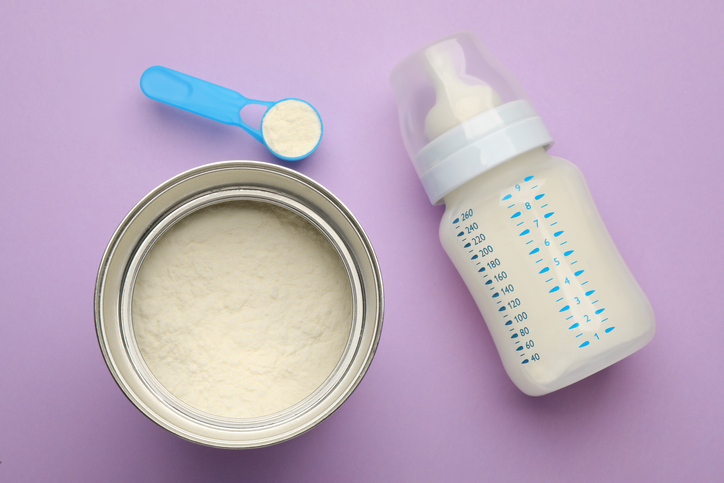Government health agencies have launched an effort to ensure “quality, safety, nutritional adequacy, and resilience” of infant formula in the United States.
Under Operation Stork Speed, the Food and Drug Administration (FDA) will review the nutrients in infant formula and increase testing for heavy-metal contamination. Companies will have to provide transparent and clear labeling on their products and communicate those changes to the public. Operation Stork Speed is the federal government’s first comprehensive review of infant formula since 1998.
The initiative also directs the FDA to collaborate with the National Institutes of Health (NIH) and other scientific bodies “to address priority scientific research gaps regarding short- and long-term health outcomes associated with formula feeding in infancy and childhood across the lifespan,” states the news release.
“The FDA will use all resources and authorities at its disposal to make sure infant formula products are safe and wholesome for the families and children who rely on them,” said Health and Human Services Secretary Robert F. Kennedy, Jr. in the directive. “Helping each family and child get off to the right start from birth is critical to our pursuit to Make America Healthy Again.”
Metals in Formula
The announcement of Operation Stork Speed came a day after Consumer Reports published an investigation that found contaminants in half of the 41 formulas its researchers tested.
Data on formula and nutritional directives from the medical community are long overdue, says Kathleen Berchelmann, M.D., a pediatrician and founder and president of MyCatholicDoctor.
“There are certain populations, especially the immunosuppressed population and sick babies, that this [particularly] impacts,” said Berchelmann. “It’s been known for a very long time that there’s a certain acceptable level for safety.”
Babies in neonatal intensive care are especially susceptible to contaminants and illnesses given their immature immune system, and contaminated formula can have detrimental, even deadly effects.
“Families are already stressed and traumatized with their baby’s illness; they should not have increased stress regarding formula safety,” said Anna Camacho, a board-certified family and neonatal nurse practitioner. “I have had parents ask me if the formula is safe, so this is certainly a concern on their minds. As far as the outpatient community, it has also affected parents’ stress levels [over] access to formula with shortages after recalls.”
Bureaucratic Delays
The FDA has organizational issues that create a time gap between evidence and data collection to implementation, which can cause safety concerns for the neonatal population, says Camacho.
“In addition, there are also ethical concerns in completing rigorous research in such a vulnerable population,” said Camacho. “That barrier is not likely to change anytime soon, but advocacy may influence the administration to correct these issues.”
Supply Disruptions
Although more highly regulated than most products on the market, there have been recent cases of infant formula contaminated during the manufacturing process.
In 2022, suspected contamination at a manufacturing facility led to widespread shortages of baby formula, causing panic.
“I think the American people need an explanation regarding what happened with the critical formula shortage and to prevent contamination, the cause of that closure and contingency,” said Berchelmann.
Other countries did not experience shortages in 2022 and 2023, Kim Corba, D.O., told Health Care News in May 2022.
Consumers should be asking why there are no supply safeguards in place, says Berchelmann. “We wouldn’t do this for other critical resources,” said Berchelmann. “There is and should always be contingency planning.”
Limited Competition
The federal government’s supplemental nutrition program for Women, Infants, and Children funds two companies, Similac and Enfamil which could be causing market distortions.
“The American people need an answer as to why a small number of organizations have limited competition,” said Berchelmann. “More locations of production would allow for less contamination when it comes to safety and access. I think the shortage opened eyes to this ridiculous situation for this limited number of factories making formula. When we run into contamination, we run into a critical shortage in our country.”
Though the gold standard for infant nutrition is breastmilk, consumers depend heavily on infant formula in the United States. Nearly 20 percent of American newborns are fed formula exclusively early in life, according to the Centers for Disease Control and Prevention. At six months of age, the number of infants on formula as part of their diet has increased to 75 percent.
“Breastfeeding is the optimal source of nutrition, so [it] should always be encouraged, regardless of a formula crisis,” said Camacho. “No formula can replicate all the benefits of breastfeeding. However, not every mother can breastfeed, for various reasons.”
To encourage breastfeeding, Camacho says education and support services for breastfeeding should begin before a woman is pregnant, to help normalize it and dispel myths, and if a woman cannot breastfeed, she should be able to rely on formula as a safe alternative.
“First and foremost, breastfeeding is supported almost universally by pediatricians as the best choice, but we recognize that there are many people, for many good reasons, who cannot breastfeed,” said Berchelmann. “Formula is a necessary essential for our babies, and the future of America needs good nutrition for babies.”
Ashley Bateman ([email protected]) writes from Virginia.



